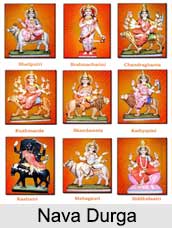 Nava Durga is the nine forms of Goddess Durga which represents the composite form of the deity. The different forms are worshipped together during the Navratri festival. The names of the nine forms differ in various texts. There are two types of lists available, one is known as Skandayamala Tantra and the other is known as Devi Mahatmyam of the Markandeya Purana. The forms of Durgas in both the cases have been discussed below
Nava Durga is the nine forms of Goddess Durga which represents the composite form of the deity. The different forms are worshipped together during the Navratri festival. The names of the nine forms differ in various texts. There are two types of lists available, one is known as Skandayamala Tantra and the other is known as Devi Mahatmyam of the Markandeya Purana. The forms of Durgas in both the cases have been discussed below
Nava Durga of Skandayamala Tantra
Goddess Durga is worshipped in the form of nine figures. One of them is placed in the middle and the remaining eight figures correspond to the eight points of the compass. These Goddesses are also known by the names of Rudra Chanda, Prachanda, Chandogra, Chandanayika, Chanda, Chandavati, Chandarupa, Atichandika and Ugrachandika.
Nava Durga of Devi Mahatmyam
The Devi Mahatmyam describes the Nava Durgas in a different way from the Skandayamala Tantra. These have been described below:
Shailaputri: Shailaputri is the 1st among Nava Durga. Her worship takes place on the first day of Navratri. In her four arms she holds sutra, damaru, sula and ghanta. Her head is decorated with the crown of the matted locks of hair. Her emblem is the bull.
Brahmacharini: Brahmacharini is worshipped on the second day of Navratri and is the second form of Mother Goddess. The Goddess possesses four arms, two of which are in Abhaya Mudra and Varada Mudra. The remaining two hands carry a sula and an aksamala. She is seated over the red lotus and has a goose as her vehicle.
Chandraghanta: Chandraghanta is the third form of Goddess Durga. She is worshipped on the third day of Navratri. This form of the Goddess bestows enormous strength and welfare. She has a semi circular moon that looks like a bell. Hence, she is known as Chandraghanta.
Kushmanda: Kushmanda is the fourth Goddess in the series of Nava Durgas. The Goddess is worshipped on the fourth day of Navratri. She holds two pitchers full of blood in her hands and create the universe with her smile. She forms the solar system projecting her power to Lord Surya.
Skandamata: Skandamata possesses four hands. With two hands she holds lotuses while with the third one she holds her son Skanda i.e. Lord Kartikeya. The fourth hand is in Varada Mudra. She is worshipped on the fifth day of Navratri. The lion is her vehicle.
Katyayani: Katyayani is the sixth form of Goddess Durga. She is known as Katyayani as she has emerged from the hermitage of the Sage Katyayana. She is also known as "Vindhyavasini" as she had resided in the Vindhya mountain range. The Goddess is worshipped on the sixth day of Navratri.
Kalaratri: Kalaratri is the seventh form of Goddess Durga and is worshipped on the seventh day of Navratri. The Goddess is said to be the destroyer of ghosts, spirits and other demonic powers. She is portrayed half naked mounted over an ass. She wears a kind of anklet made of iron spikes on her left foot.
Mahagauri: Mahagauri is the eighth form of Goddess Durga. She is worshipped in the eighth day of Navratri. She is the consort of Lord Shiva, popularly known as Parvati. She is regarded as the daughter of Daksha. She is portrayed as calm and peaceful.
Siddhidatri: Siddhidatri is the ninth and the last Goddess of the Nava Durga. She is worshipped on the ninth day of Navratri. The Goddess is seated on a lotus and has four hands. Siddhidatri has supernatural healing powers.




















